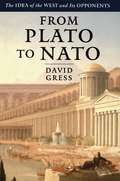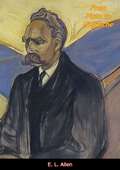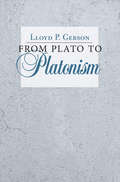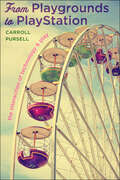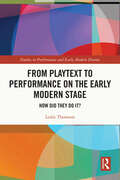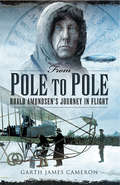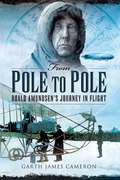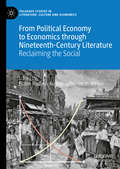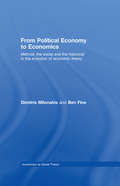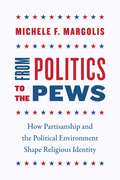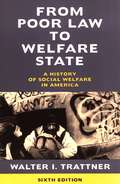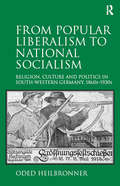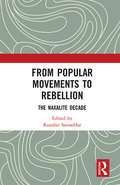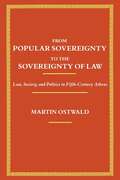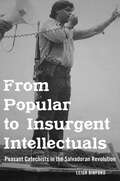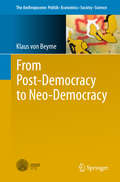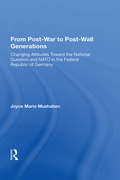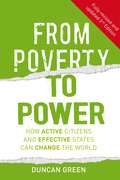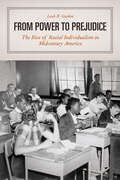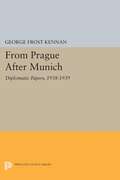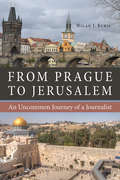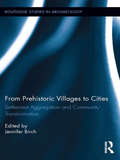- Table View
- List View
From Plato to Lumière
by Timothy Barnard Andre GaudreaultWith this lucid translation of Du litteraire au filmique, André Gaudreault's highly influential and original study of film narratology is now accessible to English-language audiences for the first time. Building a theory of narrative on sources as diverse as Plato, The Arabian Nights,and Proust, From Plato to Lumière challenges narratological orthodoxy by positing that all forms of narrative are mediated by an "underlying narrator" who exists between the author and narrative text. Offering illuminating insights, definitions, and formal distinctions, Gaudreault examines the practices of novelists, playwrights, and filmmakers and applies his theory to the early cinema of the Lumière brothers and more recent films. He also enhances our understanding of how narrative develops visually without language - monstration - by detailing how the evolution of the medium influenced narratives in cinema. From Plato to Lumière includes a translation of Paul Ricoeur's preface to the French-language edition as well as a new preface by Tom Gunning. It is a must-read for cinema and media students and scholars and an essential text on the study of narrative.
From Plato to NATO
by David GressAn in-depth intellectual history of the Western idea and a passionate defense of its importance to America's future, From Plato to NATO is the first book to make sense of the legacy of the West at a time when it is facing its greatest challenges. Readers of Francis Fukuyama, John Gray, Samuel Huntington, and other analysts of the dilemmas of Western nations in the twenty-first century will find in David Gress's original account a fuller description of what the West really is and how, with the best of intentions, it has been misrepresented. Most important, they will encounter a new vision of Western identity and how it can be recovered. Early in the twentieth century, American educators put together a story of Western civilization, its origins, history, and promise that for the subsequent fifty years remained at the heart of American college education. The story they told was of a Western civilization that began with the Greeks and continued through 2,500 years of great books and great ideas, culminating in twentieth-century progressive liberal democracy, science, and capitalist prosperity. In the 1960s, this Grand Narrative of the West came under attack. Over the next thirty years, the critics turned this old story into its opposite: a series of anti-narratives about the evils, the failures, and the betrayals of justice that, so they said, constituted Western history. The victory of Western values at the end of the cold war, the spread of democracy and capitalism, and the worldwide impact of American popular culture have not revived the Grand Narrative in the European and American heartlands of the West. David Gress explains this paradox, arguing that the Grand Narrative of the West was flawed from the beginning: that the West did not begin in Greece and that, in morality and religion, the Greeks were an alien civilization whose contribution was mediated through Rome and Christianity. Furthermore, in assuming a continuity from the Greeks to modern liberalism, we have mistakenly downplayed or rejected everything in between, focusing on the great ideas and the great books rather than on real history with all its ambiguities, conflicts, and contradictions. The heart of Gress's case for the future of the West is that the New must remember its roots in the Old and seek a synthesis. For as the attacks have demonstrated, the New West cannot stand alone. Its very virtues -- liberty, reason, progress -- grew out of the Old West and cannot flourish when removed from that rich soil.
From Plato to Nietzsche
by E. L. AllenIDEAS THAT SHAPE OUR LIVESThis book is a clear, comprehensive guide to the philosophic and religious concepts of the world’s outstanding philosophers.Here are the great thoughts and ideas of the Western mind, selected and explained with magnificent precision by an eminent scholar.It is an illuminating portrait of man’s intellectual and moral struggle to understand the world and the meaning of human life and destiny.“Any intelligent student will have his appetite whetted by a study or perusal of this book.”—HIGHER EDUCATION JOURNAL
From Plato to Platonism
by Lloyd P. GersonWas Plato a Platonist? While ancient disciples of Plato would have answered this question in the affirmative, modern scholars have generally denied that Plato’s own philosophy was in substantial agreement with that of the Platonists of succeeding centuries. In From Plato to Platonism, Lloyd P. Gerson argues that the ancients are correct in their assessment. He arrives at this conclusion in an especially ingenious manner, challenging fundamental assumptions about how Plato’s teachings have come to be understood. Through deft readings of the philosophical principles found in Plato's dialogues and in the Platonic tradition beginning with Aristotle, he shows that Platonism, broadly conceived, is the polar opposite of naturalism and that the history of philosophy from Plato until the seventeenth century was the history of various efforts to find the most consistent and complete version of "anti-naturalism." Gerson contends that the philosophical position of Plato—Plato’s own Platonism, so to speak—was produced out of a matrix he calls "Ur-Platonism." According to Gerson, Ur-Platonism is the conjunction of five "antis" that in total arrive at anti-naturalism: anti-nominalism, anti-mechanism, anti-materialism, anti-relativism, and anti-skepticism. Plato’s Platonism is an attempt to construct the most consistent and defensible positive system uniting the five "antis." It is also the system that all later Platonists throughout Antiquity attributed to Plato when countering attacks from critics including Peripatetics, Stoics, and Sceptics. In conclusion, Gerson shows that Late Antique philosophers such as Proclus were right in regarding Plotinus as "the great exegete of the Platonic revelation."
From Playgrounds to PlayStation: The Interaction of Technology and Play
by Carroll PursellHow technology shapes play in America—and vice versa.In this romp through the changing landscape of nineteenth- and twentieth-century American toys, games, hobbies, and amusements, senior historian of technology Carroll Pursell poses a simple but interesting question: What can we learn by studying the relationship between technology and play? From Playgrounds to PlayStation explores how play reflects and drives the evolution of American culture. Pursell engagingly examines the ways in which technology affects play and play shapes people. The objects that children (and adults) play with and play on, along with their games and the hobbies they pursue, can reinforce but also challenge gender roles and cultural norms. Inventors—who often talk about "playing" at their work, as if motivated by the pure fun of invention—have used new materials and technologies to reshape sports and gameplay, sometimes even crafting new, extreme forms of recreation, but always responding to popular demand.Drawing from a range of sources, including scholarly monographs, patent records, newspapers, and popular and technical journals, the book covers numerous modes and sites of play. Pursell touches on the safety-conscious playground reform movement, the dazzling mechanical innovations that gave rise to commercial amusement parks, and the media's colorful promotion of toys, pastimes, and sporting events. Along the way, he shows readers how technology enables the forms, equipment, and devices of play to evolve constantly, both reflecting consumer choices and driving innovators and manufacturers to promote toys that involve entirely new kinds of play—from LEGOs and skateboards to beading kits and videogames.
From Playgrounds to Playstation: The Interaction of Technology & Play
by Carroll PursellThis “engaging social history of play” explores how technology and culture have shaped toys, games, and leisure—and vice versa (Choice).In this romp through the changing landscape of nineteenth- and twentieth-century American toys, games, hobbies, and amusements, technology historian Carroll Pursell poses a simple but interesting question: What can we learn by studying the relationship between technology and play?From Playgrounds to PlayStation explores how play reflects and drives the evolution of American culture. Pursell engagingly examines the ways in which technology affects play and play shapes people. The objects that children (and adults) play with and play on, along with their games and the hobbies they pursue, can reinforce but also challenge gender roles and cultural norms. Inventors—who often talk about “playing” at their work, as if motivated by the pure fun of invention—have used new materials and technologies to reshape sports and gameplay, sometimes even crafting new, extreme forms of recreation, but always responding to popular demand.Drawing from a range of sources, including scholarly monographs, patent records, newspapers, and popular and technical journals, the book covers numerous modes and sites of play. Pursell touches on the safety-conscious playground reform movement, the dazzling mechanical innovations that gave rise to commercial amusement parks, and the media’s colorful promotion of toys, pastimes, and sporting events. Along the way, he shows readers how technology enables the forms, equipment, and devices of play to evolve constantly, both reflecting consumer choices and driving innovators and manufacturers to promote toys that involve entirely new kinds of play—from LEGOs and skateboards to beading kits and videogames.
From Playtext to Performance on the Early Modern Stage: How Did They Do It? (Studies in Performance and Early Modern Drama)
by Leslie ThomsonThis book reconsiders the evidence for what we know (or think we know) about early modern performance conditions. This study encourages a new recognition and treatment of certain aspects of the plays as evidence – and demonstrates the significance of the implications of that new information. This book is also an assessment of the competing narratives about the processes involved in early modern performance: about the status of manuscript playbooks, about the parts that players memorized, about the functions of the bookkeeper, about casting, about prompting, and about rehearsal practices. Leslie Thomson investigates the bases for the interdependent beliefs that an early modern player relied only on his part to prepare for a performance, that rehearsal was minimal, and that a bookkeeper compensated for these circumstances by prompting any player who was "out of his part." By focusing on often ignored (or downplayed) requirements and challenges of early modern play texts, Thomson provides evidence for answers that will foster a more nuanced and thorough understanding of original performance practices. That will, in turn, influence how we read, study, and edit the plays. This exploration will be of great interest to theatre and performance researchers, graduate students, teachers of early modern drama at the undergraduate and graduate levels, performers, directors, editors.
From Pole to Pole: Roald Amundsen's Journey in Flight
by Garth James CameronRoald Amundsen (1872-1928) was the most successful polar explorer of his era using sledges, dogs, ski and ships. He is mainly remembered for being the first man to reach the South Pole on 14 December 1911. What is less often remembered is that he was also the first man to reach the North Pole on 12 May 1926 as the leader of the Amundsen- Ellsworth-Nobile expedition in the airship Norge. His involvement in aviation from 1909 to his death in 1928, has not been the subject of a detailed study until now.This book explores Amundsen's enthusiasm for flight from the moment he read about Bleriot's flight across the English Channel in an aeroplane on 25 July 1909. From that moment onwards he saw the potential of aircraft as vehicles to explore portions of the globe that remained unexplored in the first quarter of the 20th century. The man-lifting kites built by Einar Sem-Jacobsen took the life of his second in command, Ole Engelstad and were carried, but not used, during his 1910-1912 expedition to the South Pole. He saw aeroplanes flying in America and Germany in 1913 and in 1914 he was taught to fly by Sem-Jacobsen. He passed his flight test on a Farman Longhorn biplane on 1 June 1914 and in mid-1915 was issued with the Fédération Aéronautique Internationale (Norge) aeroplane pilot's certificate number one. He bought a Farman biplane to take with him on an expedition to the North Polar Sea but the outbreak of the Great War stopped the Expedition and Amundsen gave his Farman to the Norwegian government. After the war he acquired a Curtiss Oriole biplane and two Junkers F13's then in 1925 he embarked on a flight, which he barely survived, to the North Pole in two Dornier Wal flying boats. 1926 brought long delayed success when the Norge flew to the Pole and on to Alaska. On 18 June 1928 he and five companions took off from Tromso on a search and rescue flight for the missing airship Italia and were never seen again.
From Pole to Pole: Roald Amundsen?s Journey in Flight
by Garth James CameronRoald Amundsen was the most successful polar explorer of his era using sledges, dogs, skis, and ships. He is mainly remembered for being the first man to reach the South Pole on December 14, 1911. What is less often remembered is that he was also the first man to reach the North Pole on May 12, 1926, as the leader of the Amundsen-Ellsworth-Nobile expedition in the airship Norge. His involvement in aviation from his experiments with man-lifting kites in 1909 to his death in 1928 while flying from Norway to Spitsbergen has not been the subject of a detailed study until now.From Pole to Pole explores Amundsen's enthusiasm for flight from the moment he read about Blériot's flight across the English Channel in an airplane. In June 1928 Amundsen and five companions took off in a search and rescue flight for the missing airship Italia and were never seen again. The only traces of the men and their aircraft were a tip float and an empty fuel tank which washed up on the coast of northern Norway several months later. Searches of the seabed near Bear Island for the remains of the Latham 47 flying boat he was flying in took place in 2004 and 2009, and interest in the mystery of his disappearance remains high.
From Political Economy to Economics through Nineteenth-Century Literature: Reclaiming the Social (Palgrave Studies in Literature, Culture and Economics)
by Elaine Hadley Sarah Winter Audrey JaffeFocusing on the transition from political economy to economics, this volume seeks to restore social content to economic abstractions through readings of nineteenth-century British and American literature. The essays gathered here, by new as well as established scholars of literature and economics, link important nineteenth-century texts and histories with present-day issues such as exploitation, income inequality, globalization, energy consumption, property ownership and rent, human capital, corporate power, and environmental degradation. Organized according to key concepts for future research, the collection has a clear interdisciplinary, humanities approach and international reach. These diverse essays will interest students and scholars in literature, history, political science, economics, sociology, law, and cultural studies, in addition to readers generally interested in the Victorian period.
From Political Economy to Economics: Method, the social and the historical in the evolution of economic theory (Economics as Social Theory)
by Ben Fine Dimitris MilonakisEconomics has become a monolithic science, variously described as formalistic and autistic with neoclassical orthodoxy reigning supreme. So argue Dimitris Milonakis and Ben Fine in this new major work of critical recollection. The authors show how economics was once rich, diverse, multidimensional and pluralistic, and unravel the processes that lead to orthodoxy’s current predicament. The book details how political economy became economics through the desocialisation and the dehistoricisation of the dismal science, accompanied by the separation of economics from the other social sciences, especially economic history and sociology. It is argued that recent attempts from within economics to address the social and the historical have failed to acknowledge long standing debates amongst economists, historians and other social scientists. This has resulted in an impoverished historical and social content within mainstream economics. The book ranges over the shifting role of the historical and the social in economic theory, the shifting boundaries between the economic and the non-economic, all within a methodological context. Schools of thought and individuals, that have been neglected or marginalised, are treated in full, including classical political economy and Marx, the German and British historical schools, American institutionalism, Weber and Schumpeter and their programme of Socialökonomik, and the Austrian school. At the same time, developments within the mainstream tradition from marginalism through Marshall and Keynes to general equilibrium theory are also scrutinised, and the clashes between the various camps from the famous Methodenstreit to the fierce debates of the 1930s and beyond brought to the fore. The prime rationale underpinning this account drawn from the past is to put the case for political economy back on the agenda. This is done by treating economics as a social science once again, rather than as a positive science, as has been the inclination since the time of Jevons and Walras. It involves transcending the boundaries of the social sciences, but in a particular way that is in exactly the opposite direction now being taken by "economics imperialism". Drawing on the rich traditions of the past, the reintroduction and full incorporation of the social and the historical into the main corpus of political economy will be possible in the future.
From Politics to the Pews: How Partisanship and the Political Environment Shape Religious Identity (Chicago Studies In American Politics Ser.)
by Michele F. MargolisOne of the most substantial divides in American politics is the “God gap.” Religious voters tend to identify with and support the Republican Party, while secular voters generally support the Democratic Party. Conventional wisdom suggests that religious differences between Republicans and Democrats have produced this gap, with voters sorting themselves into the party that best represents their religious views. Michele F. Margolis offers a bold challenge to the conventional wisdom, arguing that the relationship between religion and politics is far from a one-way street that starts in the church and ends at the ballot box. Margolis contends that political identity has a profound effect on social identity, including religion. Whether a person chooses to identify as religious and the extent of their involvement in a religious community are, in part, a response to political surroundings. In today’s climate of political polarization, partisan actors also help reinforce the relationship between religion and politics, as Democratic and Republican elites stake out divergent positions on moral issues and use religious faith to varying degrees when reaching out to voters.
From Pompeii
by Ingrid D. RowlandWhen Vesuvius erupted in 79 CE, the force of the explosion blew the top right off the mountain, burying nearby Pompeii in a shower of volcanic ash. Ironically, the calamity that proved so lethal for Pompeii's inhabitants preserved the city for centuries, leaving behind a snapshot of Roman daily life that has captured the imagination of generations. The experience of Pompeii always reflects a particular time and sensibility, says Ingrid Rowland. From Pompeii: The Afterlife of a Roman Town explores the fascinating variety of these different experiences, as described by the artists, writers, actors, and others who have toured the excavated site. The city's houses, temples, gardens--and traces of Vesuvius's human victims--have elicited responses ranging from awe to embarrassment, with shifting cultural tastes playing an important role. The erotic frescoes that appalled eighteenth-century viewers inspired Renoir to change the way he painted. For Freud, visiting Pompeii was as therapeutic as a session of psychoanalysis. Crown Prince Hirohito, arriving in the Bay of Naples by battleship, found Pompeii interesting, but Vesuvius, to his eyes, was just an ugly version of Mount Fuji. Rowland treats readers to the distinctive, often quirky responses of visitors ranging from Wolfgang Amadeus Mozart, Charles Dickens, and Mark Twain to Roberto Rossellini and Ingrid Bergman. Interwoven throughout a narrative lush with detail and insight is the thread of Rowland's own impressions of Pompeii, where she has returned many times since first visiting in 1962.
From Poor Law to Welfare State, 6th Edition: A History of Social Welfare in America
by Walter I. TrattnerOver twenty-five years and through five editions, Walter I. Trattner's From Poor Law to Welfare State has served as the standard text on the history of welfare policy in the United States. The only comprehensive account of American social welfare history from the colonial era to the present, the new sixth edition has been updated to include the latest developments in our society as well as trends in social welfare.<P><P> Trattner provides in-depth examination of developments in child welfare, public health, and the evolution of social work as a profession, showing how all these changes affected the treatment of the poor and needy in America. He explores the impact of public policies on social workers and other helping professions -- all against the backdrop of social and intellectual trends in American history. From Poor Law to Welfare State directly addresses racism and sexism and pays special attention to the worsening problems of child abuse, neglect, and homelessness. Topics new to this sixth edition include:<P> * A review of President Clinton's health-care reform and its failure, and his efforts to "end welfare as we know it"<P> * Recent developments in child welfare including an expanded section on the voluntary use of children's institutions by parents in the nineteenth century, and the continued discrimination against black youth in the juvenile justice system<P> * An in-depth discussion of Charles Murray and Richard Herrnstein's controversial book, The Bell Curve, which provided social conservatives new weapons in their war on the black poor and social welfare in general<P> * The latest information on AIDS and the reappearance of tuberculosis -- and their impact on public health policy<P> * A new Preface and Conclusion, and substantially updated Bibliographies<P> Written for students in social work and other human service professions, From Poor Law to Welfare State: A History of Social Welfare in America is also an essential resource for historians, political scientists, sociologists, and policymakers.
From Popular Liberalism to National Socialism: Religion, Culture and Politics in South-Western Germany, 1860s-1930s
by Oded Heilbronner’Long live liberty, equality, fraternity and dynamite’ So went the traditional slogan of the radical liberals in Greater Swabia, the south-western part of modern Germany. This book investigates the development of what the author terms ’popular liberalism’ in this region, in order to present a more nuanced understanding of political and cultural patterns in Germany up to the early 1930s. In particular, the author offers an explanation for the success of National Socialism before 1933 in certain regions of South Germany, arguing that the radical liberal sub-culture was not subsumed by the Nazi Party, but instead changed its form of representation. Together with the famous völkish fraction and the leftist fraction within the chapters of the Nazi Party, there were radical-liberal associations, ex-members of radical-liberal parties, sympathizers with these parties, and notables with a radical orientation derived from family and regional traditions. These people and associations believed that the Nazi Party could fulfil their radical - liberal vision, rooted in the local democratic and liberal traditions which stretched from 1848 to the early 20th century. By looking afresh at the relationship between local-regional identities and national politics, this book makes a major contribution to the study of the roots of Nazism.
From Popular Movements to Rebellion: The Naxalite Decade
by Ranabir SamaddarFrom Popular Movements to Rebellion: The Naxalite Decade argues that without an understanding of the popular sources of the rebellion of that time, the age of the Naxalite revolt will remain beyond our understanding. Many of the chapters of the book bring out for the first time unknown peasant heroes and heroines of that era, analyses the nature of the urban revolt, and shows how the urban revolt of that time anticipated street protests and occupy movements that were to shake the world forty-fifty years later. This is a moving and poignant book. Some of the essays are deeply reflective about why the movement failed and was at the end alienated. Ranabir Samaddar says that, the Naxalite Movement has been denied a history. The book also carries six powerful short stories written during the Naxalite Decade and which are palpably true to life of the times. The book has some rare photographs and ends with newspaper clippings from the period. As a study of rebellious politics in post-Independent India, this volume with its focus on West Bengal and Bihar will stand out as an exceptional history of contemporary times. From Popular Movements to Rebellion: The Naxalite Decade will be of enormous relevance to students and scholars of history, politics, sociology and culture, and journalists and political and social activists at large. Please note: Taylor & Francis does not sell or distribute the Hardback in India, Pakistan, Nepal, Bhutan, Bangladesh and Sri Lanka
From Popular Sovereignty to the Sovereignty of Law: Law, Society, and Politics in Fifth-Century Athens
by Martin OstwaldAnalyzing the "democratic" features and institutions of the Athenian democracy in the fifth century B.C., Martin Ostwald traces their development from Solon's judicial reforms to the flowering of popular sovereignty, when the people assumed the right both to enact all legislation and to hold magistrates accountable for implementing what had been enacted.
From Popular to Insurgent Intellectuals: Peasant Catechists in the Salvadoran Revolution
by Leigh BinfordFrom Popular to Insurgent Intellectuals explains how a group of Catholic lay catechists educated in liberation theology came to take up arms and participate on the side of the rebel FMLN during El Salvador’s revolutionary war (1980-92). In the process they became transformed from popular intellectuals to insurgent intellectuals who put their organizational and cognitive skills at the service of a collective effort to create a more egalitarian and democratic society. The book highlights the key roles that peasant catechists in northern Morazán played in disseminating liberation theology before the war and supporting the FMLN during it—as quartermasters, political activists, and musicians, among other roles. Throughout, From Popular to Insurgent Intellectuals highlights the dialectical nature of relations between Catholic priests and urban revolutionaries, among others, in which the latter learned from the former and vice-versa. Peasant catechists proved capable at making independent decisions based on assessment of their needs and did not simply follow the dictates of those with superior authority, and played an important role for the duration of the twelve-year military conflict.
From Post-democracy to Neo-Democracy (The Anthropocene: Politik—Economics—Society—Science #20)
by Klaus Von BeymeThis book of a renowned political scientist and specialist in political theory fundamentally challenges the new fashion of post-democracy by offering an outlook on ‘neo-democracy’. The political periods are similar to epochs in modern art, where ‘neo’ succeeded Post-impressionism and Post-expressionism. This book reviews the topical debate on postdemocracy and scenarios of decline in democratic theory without the alternative of dictatorship. It discusses criticism of politics in the old and new media and a new culture of protest. It addresses new forms of participation and the dangers of populism and right-wing extremism. It proposes institutional reforms of democracy, of the parliamentary system and the party state, in negotiations of coalition-building, in governmental declarations and for the policy output. The book concludes with a debate of normative models of democracy from ‘Post-democracy’ to ‘Neo-democracy’, models of justice and theories of democratic reform.
From Post-war To Post-wall Generations: Changing Attitudes Towards The National Question And Nato In The Federal Republic Of Germany
by Joyce Marie MushabenIn 1984, Italian Foreign Minister Giulio Andreotti aptly summarized popular perception of the divided nationality of the two Germanys, East and West: "There are two German states, and two they shall remain." Few would have disagreed. By the 1980s, both German states had come to occupy respected niches in the international community. Still, neither
From Poverty to Power: How Active Citizens and Effective States Can Change the World (Second Edition)
by Duncan GreenThe book discusses different types of initiatives across the world that have enhanced and expanded the powers of the powerless and emphasizes how 'active citizenship' can be a very effective way of seeking solutions.
From Power to Prejudice: The Rise of Racial Individualism in Midcentury America
by Leah N. GordonAmericans believe strongly in the socially transformative power of education, and the idea that we can challenge racial injustice by reducing white prejudice has long been a core component of this faith. How did we get here? In this first-rate intellectual history, Leah N. Gordon jumps into this and other big questions about race, power, and social justice. To answer these questions, From Power to Prejudice examines American academia—both black and white—in the 1940s and ’50s. Gordon presents four competing visions of “the race problem” and documents how an individualistic paradigm, which presented white attitudes as the source of racial injustice, gained traction. A number of factors, Gordon shows, explain racial individualism’s postwar influence: individuals were easier to measure than social forces; psychology was well funded; studying political economy was difficult amid McCarthyism; and individualism was useful in legal attacks on segregation. Highlighting vigorous midcentury debate over the meanings of racial justice and equality, From Power to Prejudice reveals how one particular vision of social justice won out among many contenders.
From Prague After Munich: Diplomatic Papers, 1938-1940 (Princeton Legacy Library #1818)
by George Frost KennanIn August 1938 George F. Kennan was assigned as Secretary of Legation in Prague. After the Germans occupied Czechoslovakia in March 1939, he stayed on in that country when most other Western observers had left. These diplomatic papers, letters, and notes are on-the-spot observations by a skilled and sensitive historian and diplomat. They offer a unique record of one of the tragic events in modern European history. Depicted here are the attempts at Germanization of Czech life, the cynical exploitation of various native organizations, the German insistence on a program of anti-Semitism, the take-over of Czech business and industry, the problems of currency and inflation.Originally published in 1968.The Princeton Legacy Library uses the latest print-on-demand technology to again make available previously out-of-print books from the distinguished backlist of Princeton University Press. These editions preserve the original texts of these important books while presenting them in durable paperback and hardcover editions. The goal of the Princeton Legacy Library is to vastly increase access to the rich scholarly heritage found in the thousands of books published by Princeton University Press since its founding in 1905.
From Prague to Jerusalem: An Uncommon Journey of a Journalist (NIU Series in Slavic, East European, and Eurasian Studies)
by Milan KubicAfter spending his childhood in Nazi-occupied Czechoslovakia and witnessing the Communist takeover of his country in 1948, a young journalist named Milan Kubic embarked on a career as a Newsweek correspondent that spanned thirty-one years and three continents, reporting on some of the most memorable events in the Middle East. Now, Kubic tells this fascinating story in depth. Kubic describes his escape to the US Zone in West Germany, his life in the Displaced Persons camps, and his arrival in 1950s America, where he worked as a butler and factory worker and served in a US Army intelligence unit during Senator Joe McCarthy's witch-hunting years. Hired by Newsweek after graduating from journalism school, Kubic covered the White House during the last year of Dwight D. Eisenhower's presidency, the US Senate run by Lyndon Johnson, and the campaign that elected President John F. Kennedy. Kubic spent twenty-six years reporting from abroad, including South America, the Indian subcontinent, and Eastern and Western Europe. Of particular interest is his account of the seventeen years—starting with the Six Day War in 1967—when he watched the Israeli-Palestinian conflict from Beirut and Jerusalem. In From Prague to Jerusalem, readers will meet the principal Israeli participants in the Irangate affair, accompany Kubic on his South American tour with Bobby Kennedy, take part in his jungle encounter with the king of Belgium, witness the inglorious end of Timothy Leary's flight to the Middle East, and observe the debunking of Hitler's bogus diaries. This riveting memoir will appeal to general readers and scholars interested in journalism, the Middle East, and US history and politics.
From Prehistoric Villages to Cities: Settlement Aggregation and Community Transformation (Routledge Studies in Archaeology #10)
by Jennifer BirchArchaeologists have focused a great deal of attention on explaining the evolution of village societies and the transition to a ‘Neolithic’ way of life. Considerable interest has also concentrated on urbanism and the rise of the earliest cities. Between these two landmarks in human cultural development lies a critical stage in social and political evolution. Throughout world, at various points in time, people living in small, dispersed village communities have come together into larger and more complex social formations. These community aggregates were, essentially, middle-range; situated between the earliest villages and emergent chiefdoms and states. This volume explores the social processes involved in the creation and maintenance of aggregated communities and how they brought about revolutionary transformations that affected virtually every aspect of a society and its culture. While there have been a number of studies that address coalescence from a regional perspective, less is understood about how aggregated communities functioned internally. The key premise explored in this volume is that large-scale, long-term cultural transformations were ultimately enacted in the context of daily practices, interactions, and what might be otherwise considered the mundane aspects of everyday life. How did these processes play out "on the ground" in diverse and historically contingent settings? What are the strategies and mechanisms that people adopt in order to facilitate living in larger social formations? What changes in social relations occur when people come together? This volume employs a broadly cross-cultural approach to interrogating these questions, employing case studies which span four continents and more than 10,000 years of human history.

